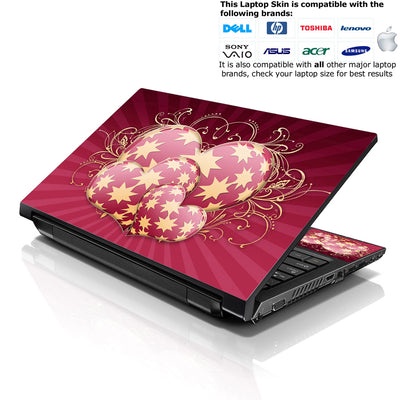Laptop skins are thin vinyl or silicone covers that are designed to adhere to the exterior of a laptop. They can provide a layer of protection against scratches, scuffs, and other forms of damage, as well as add a touch of personal style to your device.
Multiple types of laptop skins
Laptop skins come in various types, materials, and designs. Here are some of the most common types of laptop skins:
Vinyl skins: Vinyl skins are the most common type of Laptop skin. They are made from a thin layer of the vinyl material that adheres to the exterior of the laptop. They come in a wide range of colors, patterns, and designs, and are relatively easy to apply and remove.
Silicone skins: Silicone skins are made from a flexible, rubber-like material that offers a soft, textured grip to the laptop. They are more durable than vinyl skins and provide more protection against drops and impacts.
Hardshell skins: Hardshell skins are made from a thin, hard plastic material that snaps onto the laptop's exterior. They provide the most protection against scratches and impacts but can be more difficult to apply and remove.
Leather skins: Leather skins are made from a thin layer of leather material that adheres to the laptop's exterior. They provide a premium look and feel and can offer some protection against scratches and scuffs.
Designer skins: Designer skins are laptop skins that feature popular patterns and designs from famous designers, such as Kate Spade, Michael Kors, and Marc Jacobs. They can be made from vinyl, silicone, or leather materials and offer a more fashionable look.
Custom skins: Custom skins are laptop skins that can be customized with your own design, pattern, or image. They can be made from vinyl or silicone materials and are a great way to personalize your laptop.
Overall, there are many types of laptop skins to choose from, each with its own advantages and disadvantages. When choosing a laptop skin, consider the material, design, and level of protection you need to make the best decision for your device.
How to apply a laptop skin
Applying a laptop skin is a simple process that can be done in a few easy steps. Here's how to apply a laptop skin:
Clean your laptop: Before applying the skin, clean your laptop's surface thoroughly with a damp cloth to remove any dust, dirt, or debris that could interfere with the adhesion of the skin.
Position the skin: Carefully place the skin onto your laptop's surface, making sure it is aligned with the edges and corners of your device.
Smooth out any air bubbles: Starting from the center of the skin, use a credit card or similar object to smooth out any air bubbles and ensure that the skin has firmly adhered to the surface of your laptop. Work your way towards the edges, taking care to press down on any areas where the skin may not be sticking well.
Trim any excess: If the skin has excess material around the edges, trim it with a sharp pair of scissors or a craft knife to ensure a neat and tidy fit.
Enjoy your new skin: Once the skin is applied, enjoy the protection and style it provides for your laptop.
It's important to note that laptop covers skins are designed to be easily removable and shouldn't leave any residue on your laptop's surface. If you need to remove the skin, start from one corner and carefully peel it off, taking care not to damage your laptop in the process.
How to remove a laptop skin
Removing a laptop skin is a straightforward process that can be done in a few simple steps. Here's how to remove a laptop skin:
Start at a corner: Gently lift a corner of the skin with your fingernail or a plastic card. Take care not to scratch the laptop's surface or leave any residue.
Slowly peel the skin: Once you have lifted the corner, slowly peel the skin off the surface of the laptop, taking care not to pull too hard or too fast, as this can damage the laptop's surface.
Remove any residue: If there is any adhesive residue left behind after removing the skin, use a mild cleaning solution and a soft cloth to gently wipe the residue off the laptop's surface. Avoid using harsh chemicals or abrasive cleaning tools that could scratch or damage the laptop's surface.
Repeat for any remaining sections: If your laptop skin has multiple pieces, repeat the above steps for each section.
Clean your laptop: Once the skin and any residue have been removed, clean your laptop's surface thoroughly with a damp cloth to remove any dust, dirt, or debris.
It's important to note that laptop skins are designed to be easily removable and shouldn't leave any residue on your laptop's surface. If you find that the skin is difficult to remove or is leaving a residue, stop and seek assistance from a professional or the manufacturer of the skin to avoid damaging your laptop's surface.
Conclusion
In conclusion, laptop skins have become an increasingly popular way for individuals to personalize and protect their laptops. With a wide variety of options available, it's important to consider factors such as material, design, and compatibility when choosing a laptop skin. From solid colors to intricate patterns, the most popular laptop skins in the USA offer something for everyone. Applying and removing a laptop skin may seem daunting at first, but with proper instructions and care, it can be a simple process. Ultimately, investing in a high-quality laptop skin is a great way to showcase your personality while keeping your device safe from scratches and other damage.


No comments yet